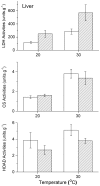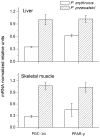Metabolic characteristics and response to high altitude in Phrynocephalus erythrurus (Lacertilia: Agamidae), a lizard dwell at altitudes higher than any other living lizards in the world
- PMID: 23951275
- PMCID: PMC3737200
- DOI: 10.1371/journal.pone.0071976
Metabolic characteristics and response to high altitude in Phrynocephalus erythrurus (Lacertilia: Agamidae), a lizard dwell at altitudes higher than any other living lizards in the world
Abstract
Metabolic response to high altitude remains poorly explored in reptiles. In the present study, the metabolic characteristics of Phrynocephaluserythrurus (Lacertilia: Agamidae), which inhabits high altitudes (4500 m) and Phrynocephalusprzewalskii (Lacertilia: Agamidae), which inhabits low altitudes, were analysed to explore the metabolic regulatory strategies for lizards living at high-altitude environments. The results indicated that the mitochondrial respiratory rates of P. erythrurus were significantly lower than those of P. przewalskii, and that proton leak accounts for 74~79% of state 4 and 7~8% of state3 in P. erythrurus vs. 43~48% of state 4 and 24~26% of state3 in P. przewalskii. Lactate dehydrogenase (LDH) activity in P. erythrurus was lower than in P. przewalskii, indicating that at high altitude the former does not, relatively, have a greater reliance on anaerobic metabolism. A higher activity related to β-hydroxyacyl coenzyme A dehydrogenase (HOAD) and the HOAD/citrate synthase (CS) ratio suggested there was a possible higher utilization of fat in P. erythrurus. The lower expression of PGC-1α and PPAR-γ in P. erythrurus suggested their expression was not influenced by cold and low PO2 at high altitude. These distinct characteristics of P. erythrurus are considered to be necessary strategies in metabolic regulation for living at high altitude and may effectively compensate for the negative influence of cold and low PO2.
Conflict of interest statement
Figures




Similar articles
-
Functional characterization and expression analysis of myoglobin in high-altitude lizard Phrynocephalus erythrurus.Comp Biochem Physiol B Biochem Mol Biol. 2015 Oct;188:31-6. doi: 10.1016/j.cbpb.2015.06.004. Epub 2015 Jun 24. Comp Biochem Physiol B Biochem Mol Biol. 2015. PMID: 26116966
-
Seasonal variation of metabolism in lizard Phrynocephalus vlangalii at high altitude.Comp Biochem Physiol A Mol Integr Physiol. 2017 Jan;203:341-347. doi: 10.1016/j.cbpa.2016.10.010. Epub 2016 Oct 26. Comp Biochem Physiol A Mol Integr Physiol. 2017. PMID: 27793615
-
The response of nitric oxide system to high Altitude in Phrynocephalus erythrurus on Qinghai-Tibetan plateau.Comp Biochem Physiol B Biochem Mol Biol. 2019 Apr;230:29-36. doi: 10.1016/j.cbpb.2019.01.009. Epub 2019 Jan 25. Comp Biochem Physiol B Biochem Mol Biol. 2019. PMID: 30690199
-
Effects of temperature on the locomotor performance and contraction properties of skeletal muscle from two Phrynocephalus lizards at high and low altitude.J Comp Physiol B. 2021 Sep;191(5):907-916. doi: 10.1007/s00360-021-01391-9. Epub 2021 Aug 3. J Comp Physiol B. 2021. PMID: 34341847 Review.
-
Performing at extreme altitude: muscle cellular and subcellular adaptations.Eur J Appl Physiol. 2003 Oct;90(3-4):360-4. doi: 10.1007/s00421-003-0872-9. Epub 2003 Jul 25. Eur J Appl Physiol. 2003. PMID: 12898262 Review.
Cited by
-
Differences in Hematological Traits between High- and Low-Altitude Lizards (Genus Phrynocephalus).PLoS One. 2015 May 8;10(5):e0125751. doi: 10.1371/journal.pone.0125751. eCollection 2015. PLoS One. 2015. PMID: 25955247 Free PMC article.
-
Elevation as a selective force on mitochondrial respiratory chain complexes of the Phrynocephalus lizards in the Tibetan plateau.Curr Zool. 2021 Apr;67(2):191-199. doi: 10.1093/cz/zoaa056. Epub 2020 Sep 22. Curr Zool. 2021. PMID: 33854537 Free PMC article.
-
Changes in intestinal microbiota across an altitudinal gradient in the lizard Phrynocephalus vlangalii.Ecol Evol. 2018 Apr 15;8(9):4695-4703. doi: 10.1002/ece3.4029. eCollection 2018 May. Ecol Evol. 2018. PMID: 29760909 Free PMC article.
-
Effects of microhabitat features on the intraspecific variability of the distribution and functional traits in a highest elevational distributed lizard.Ecol Evol. 2024 Feb 15;14(2):e10902. doi: 10.1002/ece3.10902. eCollection 2024 Feb. Ecol Evol. 2024. PMID: 38371862 Free PMC article.
-
Gene expression variations in high-altitude adaptation: a case study of the Asiatic toad (Bufo gargarizans).BMC Genet. 2017 Jul 3;18(1):62. doi: 10.1186/s12863-017-0529-z. BMC Genet. 2017. PMID: 28673260 Free PMC article.
References
-
- Storz JF, Scott GR, Cheviron ZA (2010) Phenotypic plasticity and genetic adaptation to high-altitude hypoxia in vertebrates. J Exp Biol 213: 4125-4136. doi:10.1242/jeb.048181. PubMed: 21112992. - DOI - PMC - PubMed
-
- Beall CM (2007) Two routes to functional adaptation: Tibetan and Andean high-altitude natives. Proc Natl Acad Sci USA 104: 8655-8660. doi:10.1073/pnas.0701985104. PubMed: 17494744. - DOI - PMC - PubMed
-
- León-Velarde F, Sanchez J, Bigard AX, Brunet A, Lesty C et al. (1993) High altitude tissue adaptation in Andean coots: capillarity, fibre area, fibre type and enzymatic activities of skeletal muscle. J Comp Physiol B Biochem Syst Environ Physiol 163: 52-58. doi:10.1007/BF00309665. PubMed: 8459054. - DOI - PubMed
-
- Qiu Q, Zhang G, Ma T, Qian W, Wang J et al. (2012) The yak genome and adaptation to life at high altitude. Nat Genet 44: 946–949. doi:10.1038/ng.2343. PubMed: 22751099. - DOI - PubMed
-
- Hoppeler H, Vogt M, Weibel ER, Flück M (2003) Response of skeletal muscle mitochondria to hypoxia. Exp Physiol 88: 109-119. doi:10.1113/eph8802513. PubMed: 12525860. - DOI - PubMed
Publication types
MeSH terms
Substances
LinkOut - more resources
Full Text Sources
Other Literature Sources

